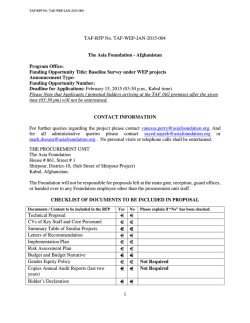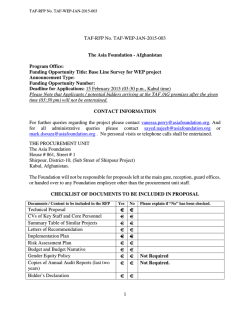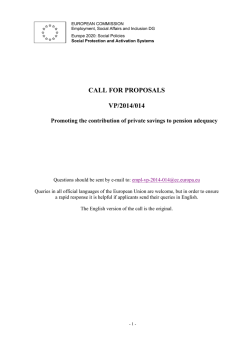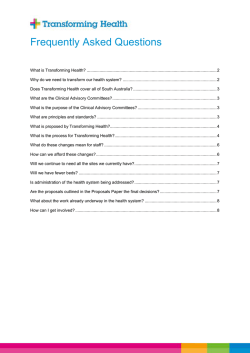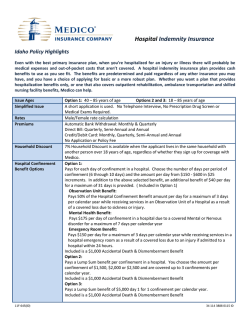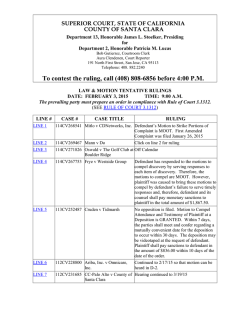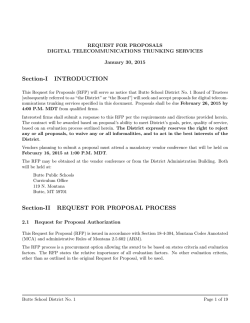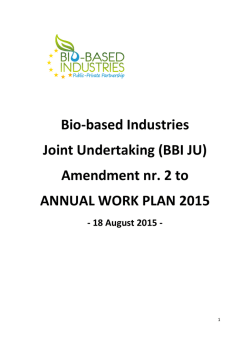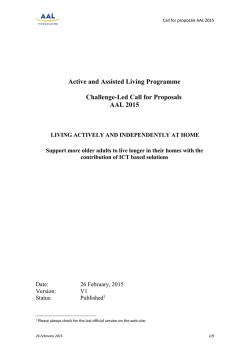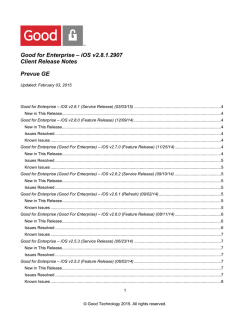
A Process for Implementation of the Strategic Plan
FORUM FalVAutomne 1991 Article original Original Article Although the principles and process for developing a strategic plan are well established, little information exists on how organizations can implement these plans. The authors developed a framework and methodology for The Ontario Cancer InstitutelPrincess Margaret Hospital that connects the implementation of the strategic plan with resource allocation and the budget; thus, the budget is a quantified expression of the strategic plan. To accomplish this, a specific cycle of events leading to the development of a corporate calendar was undertaken, which results in the establishment of the annual budget. Bien que les principes et les processus de dkveloppement d u n plan strate'gique soient bien connus, on dispose de peu dinformations sur la manidre dont ces plans peuvent &re mis en oeuvre par les organismes. Les auteurs ont klabork un cadre et une me'thodologiepour I'lnstitut du cancer de 1' Ontariolhhpital Princess Margaret qui relient la mise en oeuvre du plan stratkgique a l'attribution des ressources et au budget; ainsi, le budget est I'expression quantiJike du plan stratkgique. Pour parvenir a ce rbultat, on a empruntk une suite particulidre d' kvknements jusqu'd I' e'laboration d u n calendrier d entreprise dont le rksultat est 1' e'tablissement du budget annuel. A Process for Implementation of the Strategic Plan: From Strategic Planning toward Strategic Management by Neville C. Chenoy, Mary Jean Morrison and Donald R. Carlow M any external forces have an impact on Canadian health care organizations, the cumulative effect of which is the beginning of a fundamental transition in the delivery of health and social services in Canada.' The uncertainty and rapidity of these changes require that they should be addressed through the application of several principles that allow the organization to cope effectively with its changing environment. The following must be considered in strategic planning: * The organization's mandate must be clear as to what it can and cannot do. The organization's mission, philosophy and core values, in tandem with its mandate, provides the raison d'gtre, the social justification for its existence. The organization must be knowledgeable about its external environment and the opportunities and threats this poses to the organization. . Downloaded from hmf.sagepub.com by guest on February 6, 2015 Fall/Automne 1991 FORUM The organization must know its own strengths and weaknesses to determine how well it can cope with external pressures and changes. It must be able to identify its strategic issues and the consequencesof failure to address these issues. Strategies must be formulated to address the identified issues which are technically workable, affordable and politically acceptable to the key stakeholders. The organization must have a “vision of success,” knowing what it should look like as it implements its strategies and achieves its full ~0tential.z~ However, although the principles and processes for strategic planning are well defined, the literature is bereft of information on how organizations can implement these plans. Institutions have pursued the more limited approach by developing program-planningmethodologiesthat outline planning mechanisms and priority-setting for new and expanded programs, which, although important, constitute only one aspect of strategic management. Thus, at a time when the Canadian Council on Health Facilities Accreditation is preparing new guidelines that will require governing boards to review strategic plans of their organizations and ensure their implementation,and when provincial governments as principal funders of health care facilities are calling for more effective governance from boards, there is little information available to assist boards and their organizationsto develop a process for implementing strategic plans. This article describes the principles and processes developed by The Ontario Cancer Institutenhe Princess Margaret Hospital (OCIPMH) to implement its strategic plan. This information may be of value to other Canadian health care organizationsthat may be reviewing their future directions and exploring how they might reach their objectives. . History Canada’s largest centre for cancer treatment, research and teaching, the OCIPMH was established in 1958 and is affiliated with the University of Toronto. For the first quarter century, OCIPMH enjoyed a stable and well-endowed existence that enabled it to achieve international status in oncology. However, by the early 1980s, the institution had outgrown its physical plant because of the rapid increases in the number of cancer cases and a provincial shortage of treatment capacity. Planning for new facilities was initiated; however, the recession of 1981-82aborted the institutions’ plans for redevelopment. By the late 1980s, serious serviceproblems began to emerge at OCWMH because of overworked staff and limited facilities that were unable to respond to the increased need for Figure 1: Framework for Implementation of Strategic Plan r lI Reassessment Strategic pian I .I UI environmental issues Strategic plan equipment proposals II directly from the strategic relevant) Institutional budget services. New or expanded facilitiesbecame urgent. With the approval of the Ministry of Health, OCI/PMH began to plan once again for appropriate facilities. By the mid-l980s, a comprehensiveapproach to cancer care had emerged from the earlier emphasis on radiation and medical oncology. Multidisciplinaryprograms, psychosocial services, networking among oncology service providers, community involvementand cancer prevention strategies were a few of these directions. Under new leadership, OCWMH developed its strategic future directions and redefined its role as a comprehensivecancer centre along these lines. Many other new directions also emerged as a result of this strategic planning. Sharing of services with neighbouring hospitals was a continuing initiative, while establishing strategic alliances with other hospitals to develop a network of oncology programs was new. Multidisciplinarycare through site group organization, epidemiology and cancer prevention strategies also emerged as new ventures for the organization. Corporate reorganization, a major initiativein continuous quality improvementand the development of a Board of Directors dedicated to the institution, became necessary to support these new developments. These major and rapid changes in the internal and external environments of OCIPMH dictated a new future for the Downloaded from hmf.sagepub.com by guest on February 6, 2015 FORUM FalVAutomne 1991 Figure 2: Corporate Calendar Planning Cycle Budget 1990-91 Retreat documentation P b Annual hospital retreat b Cycle commences again 14 Review of the draft budget internallyby key groups L proposalssubmittedby dept heads to VPs for review z Executive Staft Committee Program ranking reviewed by key groups Initiationof the development of departmental budgets New programs & capital kernsfinalized organization. This was spelled out in its strategic plan; however, the plan needed a framework for its implementation. Framework for implementation of a strategic plan Implementation of the strategic plan at OCI/PMH was seen as part of a broader. integrative process, which had to bring together the strategic plan and specific tactical level plans from departmentsand proposals for new programs into a budgetbuilding process. To achieve such an integration between strategic planning and the budgeting process requires guidelines for change that reflect the organization’s preferred future directions, as expressed in its strategic plan. These guidelines also identify where priorities will be placed in supporting existing programs through departmentalbudgets; where downsizing or phasing out will occur because these programs no longer fit future directions; what criteria will be applied to review proposals for new and expanded programs; and provide the basis for assessing capital equipment requests and any new construction projects. me of such an approach is that future services and programs of the institution are proposed not on the basis of departmentalaspirations or professional demands as is often the case, but largely on the identified future directions of the organization.6-11 Downloaded from hmf.sagepub.com by guest on February 6, 2015 FORUM FaWAutomne 1991 Figure 3: OCllPMH Strategic Plan Breakdown Strategicplan ~ I 3 3 3 Goal 1 Goal 2 Develop a comprehew sive cancer centre Undertake corporate restructuring to enhance efficiency & increase quality of working life 20 projects 14 projects Goal 5 Develop a dedicated Board of Directors 7 projects Efficiently accomplish relocation of OCIPMH to University Ave. site Promote the development of provincial and national strategies for cancer control 13 projects 2 projects A framework that incorporates these principles is shown in Figure 1. To accomplish this, OCIPMH undertook a specific cycle of events through the developmentof a “corporate calendar,” eventually leading to the establishmentof the annual budget. Development of a corporate calendar A corporate calendar is defined as a set of activities as part of a repetitive process that an organization must undertake in a set time frame to establish its basic priorities and identify how it will use its resources in the next fiscal cycle and in the longer term. The implementation of the strategic plan was an integral part of the corporate calendar process leading to the formulation of the OCIPMH budget. The steps taken in this process are outlined below and shown in Figure 2. It was also important that responsibility be assigned for the Completion of each step by a specific date.* Step 1: Review of key external and internal issues Documentation was developed on external events, trends in delivery of services to cancer patients, the oncology programs needed currently and in the longer term and other relevant information. This information was distributed to all staff members who would later participate in a retreat. Step 2: Development of corporate positions Each key group in the institution must arrive at a consensus on what it sees as the priorities within the strategic plan and document its viewpoints. The viewpoints+x corporate positions-of each group are then distributed to the others so that the expectations of the different groups are identified and understood. These corporate positions then become part of the foundation for developing institutional guidelines and priorities for the coming years. For instance, medical programs are the responsibility of the medical department chiefs. Therefore, these departmental chiefs and the chairman of the Medical Advisory Committee (MAC) are required to develop their corporate position relating to future clinical developments,program changes for closures, external linkages between their department and other organizations, developmentof new referral patterns, and so on. Such a corporate position spells out where each department and the MAC as a whole would like to see the hospital place its emphasis and resources in both the coming year and future years based on its evaluation, for example, of changing demand for services, new technology and programs and investment in oncological education. Similarly, the Nursing Advisory Committee,the Research Advisory Committee, and the Department Heads and Senior Staff Committee documented their views on future developments at OCIPMH. Step 3: Identification of goals and projects from the strategic plan The future directions for OCIPMH described in the strategic plan were synthesized into five broad goals for the organization. Traditionalplanning approaches would suggest that for each goal, a number of specific, measurable, achievable and time-limited objectives should be established, along with strategies for action. Although this approach could have been taken, it was decided that a more practical way to implement the strategic plan would be to identify for each goal, specific projects drawn from the plan itself. These projects themselves had to be implemented to realize the goals. Fifty-five such projects were derived from the strategic plan, each of which was associated with one of the five goals, and every project was assigned to an individual “champion”responsible for its completion. The champion was assigned the responsibility to develop a team to define the terms of reference for the project, set its objectives and the steps to be undertaken, identify a timetable for the project and the resources needed for its completion.The Executive Staff Committee had the responsibility to decide on the priorities for implementation of projects. Some of the projects required reorganizationor work to be done in the institution that involved no financial implications. Other projects dealt with new linkages and relationships to be established with external bodies, such as the Faculty of Downloaded from hmf.sagepub.com by guest on February 6, 2015 FORUM Fall/Automne 1991 Figure 4: Status of Strategic Plan Projects (Example) Goal 1. To provide leadership in the development of a comprehensive cancer centre and to become its “HUB” Project Responsibility lor project Develop ’resident comprehensive patient care supportservices which will include psychosocial, palliative care, prosthetics, physiotherapy and rehabilitation Start date I Completion date qov. 1989 Awaiting Ministry of Health approval Current status Proposals for new and expanded programs in psychosocial and rehabilitation services have been submitted to Ministry of Health as part of 1990-91 budget and through the relocation budget. Medicine, and there were some operational projects that had financial implications. Figure 3 shows the strategicplan breakdown into goals an^ projects. Figure 4 shows the format for recording the status of the projects, which has proven to be a useful tool for monitoring progress and communicatingthe status of the various projects to the different constituencies within OCWMH. Steps 4 and 5: Annual retreat to develop guidelines for future directions The future direction of OCWMH was discussed at a two-day retreat attended by the members of the Board and key clinicians,executivesand staff members. All of the participants received a package of information relating to future projections, corporate positions of each group, goals and projects emanating from the strategic plan and other relevant informa- tion. The outcome of the retreat was the identification of those programs that required immediate attention, program priorities for the 1991-92budget and ongoing organizationalpriorities necessary to move OCIPMH closer toward its mission of becoming a comprehensivecancer centre. Step 6: Development and weighting of criteria to be applied for selection of new and expanded programs The discussions and outcomes of the retreat also provided the basis for developing criteria that would enable the institution to decide how it would select competing program proposals from the various departments.The Executive Staff Committee developed this list and determined a weighting for each criterion. These criteria would be used to assign priorities to proposals from departmentsfor new and expanded programs. Step 7: Issuance of guidelines to departments Guidelines that included the criteria that would be used to set priorities were issued to department heads to inform them of the organization’s priorities for the coming year and indicate the basis on which their departmental proposals for new or expanded programs would be assessed. Step 8: Development of proposals for new and expanded programs and capital equipment Department heads and chiefs prepared proposals for new programs and equipment taking into consideration the priorities of the organization. A special form was developed that the department heads completed to provide information on their new proposals as well as their program proposals. Step 9: Ranking of program proposals OCIPMH developed a process to rank program proposals, which included sorting the proposals into their different categories, screening proposals into “high impact” and “low impact” programs on the basis of the pre-established criteria, and ranking the high-impact program proposals in order of priority. Steps 10 and 11: Review of program-ranking by the key groups In keeping with the principle of developing a participatory process, the ranking of proposals for new and expanded programs was reviewed by the key groups in the institution. Based on their comments, the Executive Staff Committee finalized the priorities for new and expanded programs and capital projects for the coming year. Steps 12 to 17: Preparation of the institutional budget and submission to Ministry of Health In this corporate calendar process, the developmentof the budget reflects and supports the strategic directions of the organization. In a series of step-wise actions, the priorities for new and expanded programs, major capital equipment,projects emanating from the strategic plan and departmentalbudgets Downloaded from hmf.sagepub.com by guest on February 6, 2015 Fall/Automne 1991 FORUM were established on the basis of the future directions of OCWMH. The compilation of these decisions into an institutional budget resulted in a strategic management approach to resource allocation. It should be noted that in the first year (1990-91) after the developmentof the OCIPMH strategic plan, certain projects deemed vital to the organization, such as recruitment of leaders for clinical departments and developmentof psychosocial support services, were implemented as soon as possible-even before the corporate calendar was devised. With the introduction of the corporate calendar, the initiation of the remainder of strategic projects followed the above steps. In developing the budget for the next year (1991-92), the corporate calendar has been followed in a step-wise manner (Figure 2). Monitoring the implementation of the strategic plan A format has been developed to record the status of the various implementationprojects, which is used to monitor the progress of implementation(Figure 4). At OCWMH, this tool is updated quarterly to allow management to monitor the progress of implementationof the various projects. With the integration of the strategic plan into the operating budget of the institution,monitoring of the plan has been made a part of the broader institutional monitoring processes. At the corporate level, monthly financial reports and statistical and activity reports provide management with the information needed to maintain or shift course. In addition, regular reporting on OCWMH quality indicators provides information on the quality of the output of the organization. At the departmental level, plans, objectives and proposals for new and expanded programs arise from the future directions noted in the strategic plan. Monitoringat this level is effected through monthly review of financial and statistical information. In addition, departments are beginning to define their own indicators of quality and to evaluate their performance against such standards. At the present time, new and expanded program proposals from departmentsare not assessed on the basis of the ability of the department to offer a “quality” service. With further developmentsin quality indicators, the notion of quality could become a major criterion for setting priorities for new and expanded program proposals. Advantages and disadvantages of a corporate calendar Several advantages were noted in implementinga corporate calendar at OCI/PMH. 1. It is an interactive, participatory process involving all key groups in the organization. Because each group is required to develop its own corporate position and explain it to the others, there is an opportunity for better understanding of each others’ needs and aspirations; this, in turn,can enhance team-buildingand commitment in the organization. 2. In this process, future directions and specific priorities are identified by the key groups; this enables the organization to assess collectively which new programs should be developed, and which may no longer be necessary. 3. The services of the organization begin to be focused on the strategic directions of the organization rather than departmental aspirations. Members of the organization begin to see the link between the strategicplan and decisions that are subsequentlymade; thus, the activities in the corporate calendar make the strategic plan a living document. 4. By linking the various projects that emanate from a strategic plan with the operational budget, a strategic management approach to resource allocation is created. 5. The corporate calendar establishes a process and action plan with a specific timetable to implement various aspects of the strategic plan as part of the ongoing operations of the organization. The disadvantagesare that the process is time consuming, involves many people, and it requires staff support which may have cost implications. Principles for implementation of the strategic plan What was learned by OCIPMH from this experience that might be useful to others? Several principles emerge: The annual budget must be a reflection of the preferred future directions of the organization. The organization’s efforts must be directed toward achieving its own future vision. Therefore, implementationof the strategic plan must become a part of the budgeting process and the resulting budget is then a quantified expression of that plan. The implementation process must be iterative. The integration of the broad strategic plan with the annual financial planning is not a linear process; rather, it is iterative, with the end of one cycle of events becoming the startingpoint for the next cycle. Thus, a continuity is provided for the implementation process. Participation from key groups is essential. All key groups in the institution must be involved to establish guidelines for change. At OCIPh4H this involved the Downloaded from hmf.sagepub.com by guest on February 6, 2015 FORUM Fall/Automne 1991 Board of Directors, Executive Staff Committee,Medical Advisory Committee,Nursing Advisory Committee,Research Advisory Committee and Department Heads/Senior Staff Committee. Each key group must have the opportunityto present its corporate position. The key groups in the organization will have different priorities within the strategic plan. They may also perceive future directions in different ways. Therefore, if a consensus is to be reached, the key groups must be allowed to define their positions and make them known to each other so that there is a better understandingof each others' interests and expectations. There must be a process for establishing consensus among the key groups. It is essential to develop a consensus in the organization on priorities for the coming year(s) and the guidelines by which the organization will select its new programs. The annual Board retreat is a good forum for setting priorities for the future. The process of implementation must be flexible. Incorporationof the strategic plan into the budgeting process requires time. Therefore, the process must start early in the fiscal year without all of the necessary information being available. This will require not only forecasting with limited information but flexibility within the planning cycle to accommodate unexpected changes. Such flexibility is inherent in all stages of the planning cycle and unanticipated events at any time may require a re-examinationof the priorities and guidelines that had been set earlier. Final comments A process is described that attempts to create a strategic management focus at OCI/pMH in which the implementation of the strategic plan with its emphasis on the future becomes a key basis for the annual resource allocations through the budget, thus making the budget a quantified expression of the strategic plan. It is a dynamic process which will be refined as experience is gained. The outcome has been joint decisionmaking by all key players in the best interest of the entire organization. References and notes 2. Chenoy, N.C. 1984.Strategic planning: understanding and responding to a rapidly changing world. Healthcare Management Forum 5(2): 3-19. 3. Stacey, S.and Leggat, S. 1987.Strategic planning: a practical guide. HealrhCare Management Forum 8(2): 41-51. 4. Webber, J.B. and Peters, J.P. 1983.Strategic Thinking: New Frontier For Hospital Management,Chicago: American Hospital Association: 7-18,120-130. 5. Bryson, J.M. 1988.Strategic Planningfor Pubiic and Non-Profit Organizations, San Francisco: Jossey-Bass Publishers: 46-70. 6. Cook, D. 1990.Strategicplan creates a blue-print for budgeting. Healthcare Financial Management 44(5): 21-27. 7. Nyp, R.G. and Angermeier, I. 1990.Financial plan charts a hospital's course for success. Healthcare Financial Management 44(5): 30-36. 8. Glenesk, A.E. 1990.Six myths that can cloud strategic vision. Ibid: 38,4043. 9. White, S. 1990.Corporate objectives and the planning process. Dimensions in Health Service 67(1): 18-20,42. 10.Folger, J.C. 1989.Integration of strategic,financial plans vital to success. Healthcare Financial Management 43(1): 23-32. 11.Jennings, M.C. 1988.What is financially driven strategic planning? Topics in Health Care Financing 15(1): 1-8. * For a list of the dates and the assigned responsibilities,please contact Dr. Donald R. Carlow, President and Chief Executive Officer, The Ontario Cancer InstituteEhe Princess Margaret Hospital, 500 SherbourneStreet,Toronto, Ontario M4X 1K9 Neville C. Chenoy, M Pharm, MHA, CHE, is a Health Care Planning Consultant in Toronto. Mary Jean Morrison, MPA, CHE, is a Health Care Planning Consultant in Toronto. Formerly, she was Director, Project and Program Planning, The Ontario Cancer InstitutelThe Princess Margaret Hospital, Toronto. Donald R. Carlow, MI), CHE, is President and Chief Execun've Officer, The Ontario Cancer InstitutelThe Princess Margaret Hospital, Toronto. 1. Siler-Wells,G.L. 1988.Directing Change and Changing Directions: a New Policy A g e d for Canada, Ottawa: Canadian Hospital Association: 47-74. El Downloaded from hmf.sagepub.com by guest on February 6, 2015
© Copyright 2025

